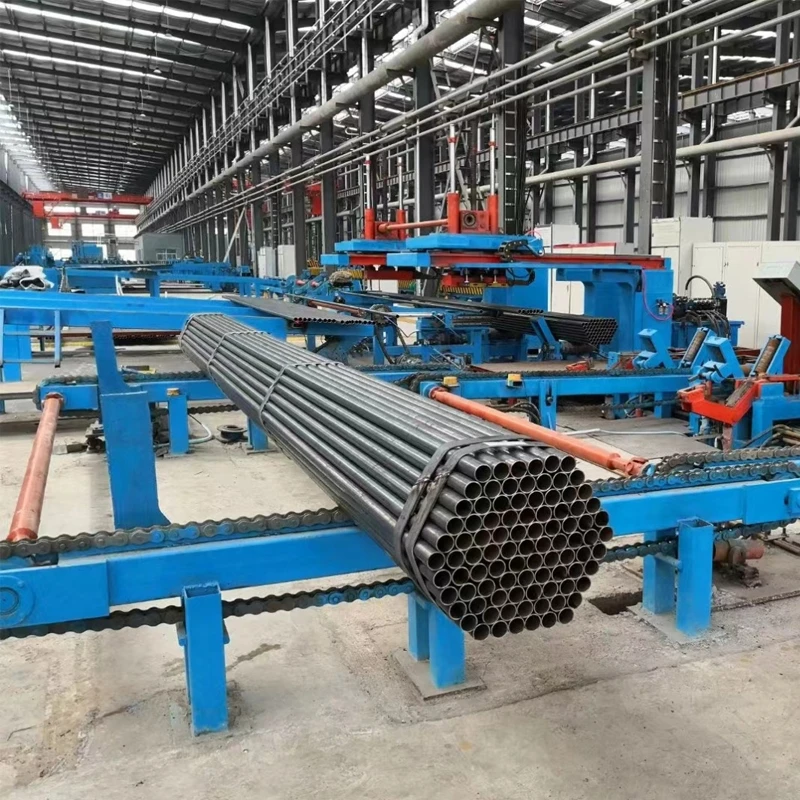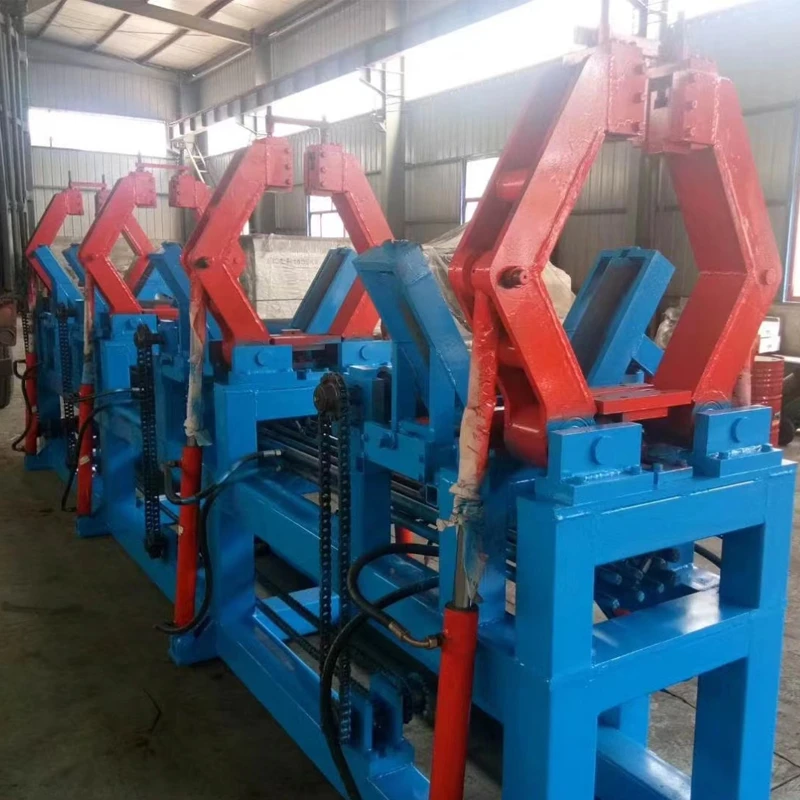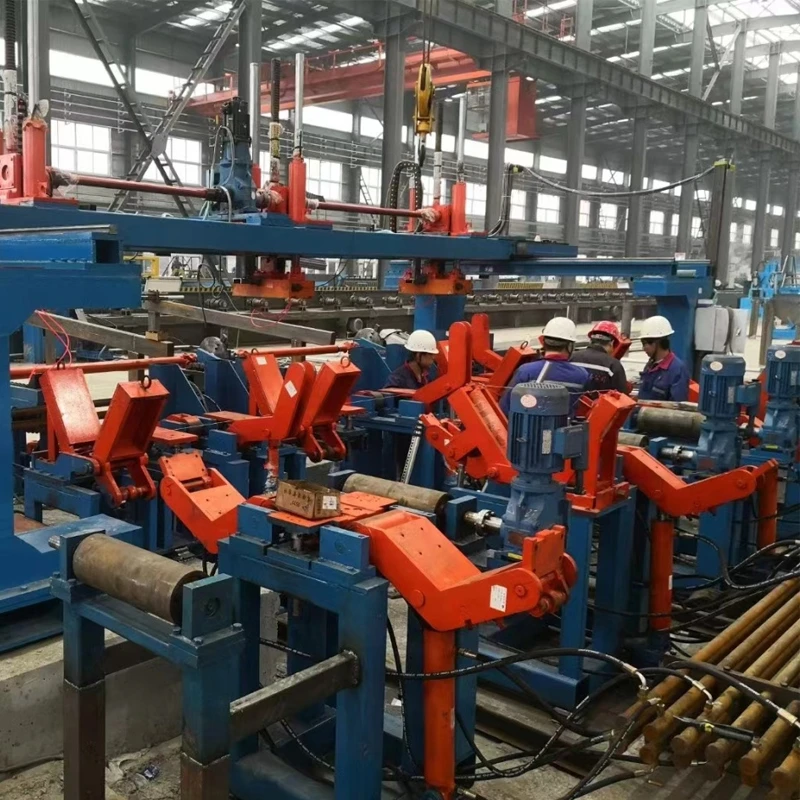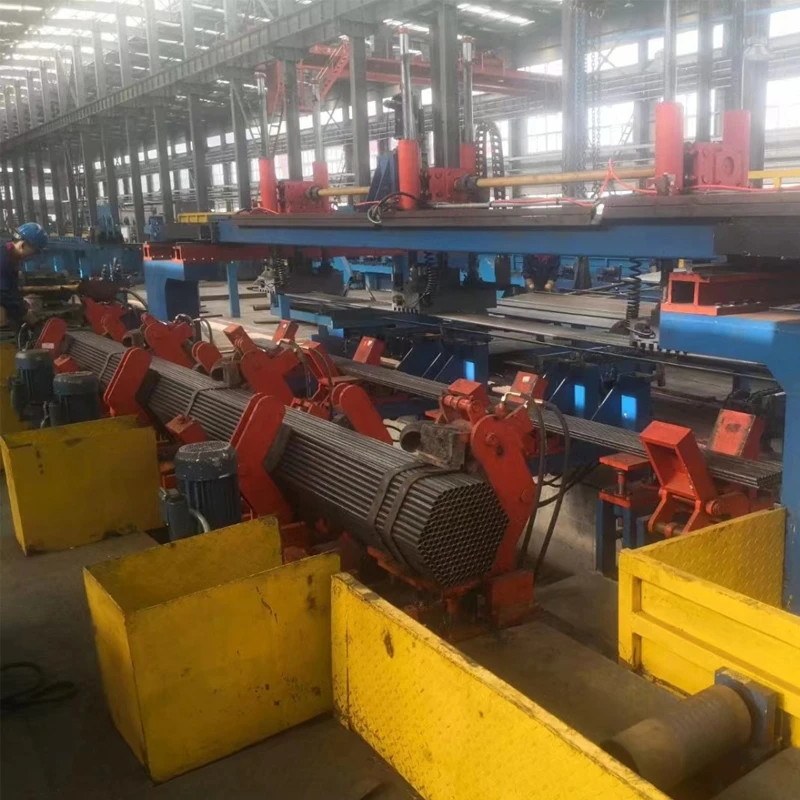Advanced Belling Machine: Efficient Pipe End Forming Solutions
In the dynamic landscape of industrial manufacturing, precision and efficiency are paramount. The belling machine stands as a cornerstone technology, particularly in the production of pipes and tubes, enabling the creation of flared or socket ends for seamless joining. This comprehensive guide delves deep into the world of belling machine technology, exploring its critical role, advanced features, and diverse applications, while also touching upon related essential equipment like the purlin machine, shutter machine, and ERW pipe machine, which collectively contribute to robust industrial infrastructure.
Industry Trends and Technological Advancements in Pipe Fabrication
The global pipe manufacturing industry is experiencing significant transformation, driven by increasing demand from infrastructure development, oil and gas, water management, and construction sectors. Key trends include the integration of Industry 4.0 principles, such as IoT and AI, for predictive maintenance and enhanced operational efficiency. Furthermore, there's a growing emphasis on sustainable manufacturing processes, requiring machines that are more energy-efficient and capable of processing a wider range of recyclable materials. The belling machine has evolved from manual or semi-automatic systems to fully automated, CNC-controlled units, offering unparalleled accuracy, repeatability, and speed.
Modern belling machines are designed to handle various materials, including PVC, PE, PP, and even composite pipes, with greater flexibility. The demand for larger diameter pipes and specialized profiles has also pushed innovation, leading to more robust and versatile belling solutions. This technological leap ensures that manufacturers can meet stringent quality standards while optimizing production costs.
Understanding the Core: Technical Parameters of a Belling Machine
A belling machine's performance is defined by several critical technical parameters that dictate its capabilities and suitability for specific applications. These parameters are crucial for optimizing production lines and ensuring product quality.
Key Technical Specifications:
- Pipe Diameter Range: Specifies the minimum and maximum pipe diameters the machine can process. Typical ranges might be from DN50 to DN630, or even larger for specialized applications.
- Wall Thickness Compatibility: The range of pipe wall thicknesses the machine can handle without compromising the belling quality. This is vital for different pressure ratings and material types.
- Belling Type: Defines the type of socket or bell produced, such as Solvent Cement (SC) socket, Rubber Ring (RR) socket, or fusion joints.
- Heating Method: Common methods include hot air circulation, infrared heating, or specialized heating dies. The choice impacts energy efficiency and heating uniformity.
- Clamping System: Hydraulic, pneumatic, or mechanical clamping mechanisms ensure the pipe is securely held during the belling process. Precision clamping prevents deformation.
- Control System: PLC (Programmable Logic Controller) or CNC (Computer Numerical Control) systems provide precise control over heating temperature, belling depth, and cycle time, often with touch-screen interfaces for ease of operation.
- Production Capacity: Measured in pipes per hour (PPH), indicating the machine's throughput. This can range from 60 PPH for smaller machines to 200+ PPH for high-speed industrial models.
- Power Consumption: Energy efficiency is a growing concern. Modern machines often incorporate energy-saving features.
- Dimensions and Weight: Physical footprint and weight are important for factory layout and installation.
Typical Belling Machine Parameter Table:
Below is a generalized table illustrating common parameters for various types of belling machines based on typical industry requirements. Actual specifications vary by model and manufacturer.
| Parameter | Small Scale (e.g., DN50-DN160) | Medium Scale (e.g., DN160-DN400) | Large Scale (e.g., DN400-DN800+) |
|---|---|---|---|
| Pipe Diameter Range (mm) | 50 - 160 | 160 - 400 | 400 - 800+ |
| Max. Wall Thickness (mm) | 8 | 25 | 60 |
| Belling Type Compatibility | SC, RR | SC, RR, Fusion | SC, RR, Fusion, Custom |
| Heating Zones | 1 - 2 | 2 - 4 | 4 - 6+ |
| Heating Method | Hot Air, Infrared | Infrared, Hot Air | Infrared, Induction |
| Control System | PLC | PLC / Basic CNC | Advanced CNC |
| Production Capacity (PPH) | 80 - 150 | 60 - 100 | 30 - 60 |
| Total Power (kW) | 10 - 25 | 25 - 60 | 60 - 150+ |
| Typical Cycle Time (seconds) | 15 - 30 | 25 - 50 | 40 - 90 |

Application Scenarios of Belling Machines
The versatility of belling machines makes them indispensable across a multitude of industries where pipe joining is critical. Their ability to create precise, consistent sockets ensures reliable and leak-proof connections, vital for long-term system integrity.
- Water Supply and Drainage Systems: The most common application. Belling machines produce pipes for potable water distribution, sewage lines, and stormwater management. The integrity of these connections is paramount to prevent leaks, water loss, and environmental contamination.
- Agriculture and Irrigation: Used for manufacturing pipes for irrigation networks, delivering water efficiently to crops. Durability and ease of installation are key advantages.
- Petrochemical Industry: While less common for direct process piping, belling machines are used for utility piping (e.g., water lines, drainage) within refinery complexes where PVC or PE pipes are suitable. The anti-corrosive properties of the materials used in conjunction with precise belling are beneficial.
- Mining and Industrial Applications: For fluid conveyance in mining operations, such as slurry transport or dewatering.
- Construction Sector: For manufacturing conduit pipes, drainage pipes, and other non-pressure applications in buildings and infrastructure projects.
- Telecommunications and Electrical Conduits: Producing protective conduits for fiber optic cables and electrical wiring, ensuring their safety and longevity.
In all these scenarios, the belling machine facilitates rapid and secure pipe installations, reducing labor costs and enhancing overall project efficiency. The precise fit created by the belling process minimizes the need for additional sealing materials, leading to more robust and long-lasting pipe networks.
Technological Advantages and Why They Matter
Modern belling machines offer significant technological advantages that translate directly into operational benefits and superior product quality. These advantages stem from advanced engineering, materials science, and automation.
- Precision and Consistency: Through sophisticated PLC/CNC control, belling machines achieve extremely tight tolerances for bell dimensions, ensuring every pipe produced is identical and fits perfectly. This reduces waste and rework.
- Energy Efficiency: Innovations in heating technology, such as optimized infrared emitters and improved insulation, reduce energy consumption significantly, lowering operational costs and environmental impact. Some machines feature intelligent heating control that adjusts power based on pipe size and material.
- Material Versatility: Capable of processing a wide range of thermoplastic materials (PVC-U, CPVC, PE, PP, PEX) with minimal adjustments, offering manufacturers flexibility in production. Special dies and heating profiles can be configured for specific material properties.
- High Production Speed: Automated feeding, precise heating, and rapid cooling cycles enable high throughput, meeting the demands of large-scale production. Cycle times can be optimized down to a few seconds per pipe for smaller diameters.
- User-Friendly Interface: Intuitive touch-screen HMIs (Human-Machine Interfaces) simplify operation, parameter setting, and diagnostics, reducing operator training time and potential errors.
- Robust Construction and Longevity: Built with high-grade steel frames and precision-engineered components, these machines are designed for continuous, heavy-duty operation, ensuring a long service life with minimal maintenance.
- Enhanced Safety Features: Incorporate multiple safety interlocks, emergency stops, and protective guarding to ensure operator safety during production.
- Reduced Maintenance: With fewer moving parts and self-lubricating components, modern belling machines require less frequent maintenance, leading to higher uptime and lower total cost of ownership.

The Detailed Manufacturing Process of a Belling Machine
The manufacturing process of a belling machine itself is a testament to precision engineering, combining robust mechanical components with sophisticated electrical and control systems. From raw material to final assembly, each step is critical for ensuring the machine's durability, accuracy, and efficiency. This process often involves a blend of traditional metalworking techniques and advanced automated processes.
Manufacturing Flow Diagram (Conceptual):
Imagine a flow diagram with arrows indicating progression:
- Raw Material Sourcing & Inspection:
- Material: High-grade structural steel (e.g., Q235, Q345) for frames, hardened alloy steels for critical moving parts (e.g., die holders, clamping jaws), aluminum alloys for heating elements, and high-quality electrical components.
- Initial Inspection: All incoming materials undergo rigorous quality checks for dimensional accuracy, chemical composition, and mechanical properties. This adheres to standards like ASTM A36 for structural steel or specific material certifications.
↓
- Component Fabrication (Casting, Forging, CNC Machining):
- Main Frame & Structural Parts: Steel plates are cut (laser or plasma cutting), bent, and welded to form the machine's robust frame. Welding processes (MIG, TIG) are precisely controlled to ensure structural integrity and minimize distortion. Stress relieving may be performed post-welding.
- Precision Parts (Dies, Clamping Jaws, Moving Mechanisms): These are often crafted from hardened tool steels.
- Casting: For complex shapes that require high strength, components like hydraulic manifolds or certain housings might be cast from ductile iron or steel alloys.
- Forging: Critical stress-bearing components, such as shafts or specialized linkages, might be forged to enhance grain structure and mechanical strength.
- CNC Machining: The backbone of precision manufacturing. Components are machined to extremely tight tolerances (e.g., ±0.01mm) using multi-axis CNC milling and turning centers. This ensures perfect alignment and smooth operation. Surface finishes are critical to prevent wear and tear.
- Heating Elements & Insulators: Fabricated from heat-resistant materials (e.g., specialized aluminum alloys for uniform heat distribution, ceramic fiber for insulation).
↓
- Surface Treatment & Finishing:
- Process: Parts undergo shot blasting to clean surfaces, followed by priming and multiple coats of industrial-grade paint for corrosion resistance and aesthetic finish. Critical surfaces may be precision ground or polished.
- Standard: Adherence to painting standards like ISO 12944 for corrosion protection.
↓
- Assembly of Mechanical Components:
- Process: Skilled technicians assemble the main frame, pipe clamping system, heating unit, belling unit (mandrel and die mechanism), and cooling station. Linear guides, bearings, and hydraulic/pneumatic cylinders are carefully installed and aligned.
- Precision: Alignment is critical and checked using laser alignment tools to ensure smooth, friction-free movement.
↓
- Electrical & Control System Integration:
- Components: PLC (e.g., Siemens, Allen-Bradley), HMI (touch screen), sensors (temperature, position), motor drives, wiring harnesses.
- Process: Electrical cabinets are wired, control panels are integrated, and sensors are installed. The PLC is programmed with the machine's operating logic, safety protocols, and HMI interface.
- Standard: Wiring and electrical safety comply with CE, UL, or other regional standards.
↓
- Testing and Quality Assurance:
- Functional Testing: Each belling machine undergoes extensive functional testing, including dry runs and processing of various pipe sizes and materials to verify performance parameters (heating uniformity, belling accuracy, cycle time).
- Safety Checks: All safety interlocks, emergency stops, and guarding mechanisms are thoroughly tested.
- Inspection Standards: Adherence to internal quality standards, often mirroring or exceeding international benchmarks like ISO 9001 for quality management systems, and specific product performance standards relevant to pipe machinery (e.g., ASTM standards for plastic pipe processing).
- Lifespan Assessment: Components are chosen for a long operational lifespan, typically designed for 15-20 years of continuous service under proper maintenance, using components with high Mean Time Between Failure (MTBF) rates.
↓
- Packaging and Shipping:
- Preparation: Machines are carefully cleaned, protected from corrosion, and securely crated for international shipping.
Throughout this process, stringent quality control measures are implemented at every stage. For instance, material certificates are always requested, welding seams are visually and sometimes non-destructively inspected, and machined parts are measured against design blueprints. This meticulous approach ensures that the final belling machine is of the highest quality, providing exceptional performance and reliability in demanding industrial environments.
Manufacturer Comparison: Choosing the Right Partner
Selecting a belling machine manufacturer involves more than just comparing price tags. It requires a thorough evaluation of their reputation, technological capabilities, after-sales support, and adherence to quality standards. Here's a comparative framework:
| Criteria | Leading Manufacturer (e.g., XH Equipment) | Mid-Tier Manufacturer | Budget Manufacturer |
|---|---|---|---|
| Technology & Innovation | State-of-the-art CNC, IoT integration, advanced heating algorithms. Patented designs. | Modern PLC, reliable heating, standard designs. | Basic PLC, conventional heating, focus on cost-effectiveness. |
| Product Quality & Durability | Premium materials, robust construction (ISO certified), high precision machining, 20+ years lifespan. | Good quality materials, solid construction, 10-15 years lifespan. | Standard materials, functional construction, 5-10 years lifespan. |
| Customization & Flexibility | Extensive customization options, tailored solutions for unique pipe types/sizes, R&D support. | Moderate customization, adaptation of existing models. | Limited customization, standard models only. |
| After-Sales Support & Service | Global network, rapid response, remote diagnostics, extensive spare parts inventory, training programs. | Regional support, standard response times, basic spare parts. | Limited support, basic troubleshooting, longer spare parts delivery. |
| Certifications & Standards | ISO 9001, CE, ASTM compliant, potentially FDA for specific applications, rigorous internal QMS. | ISO 9001, CE. | Basic compliance. |
| Client Feedback & Reputation | Strong positive feedback, repeat customers, testimonials from major industry players. High market share. | Mixed feedback, growing reputation. | Price-driven decisions, variable feedback. |
| Price Range | Premium | Mid-range | Competitive / Low |

Client Feedback & Experience:
Case Study: Global Water Solutions Provider
One of our clients, a major player in municipal water infrastructure projects, required a belling machine capable of handling large-diameter PVC pipes (up to DN630) for a significant urban water supply network expansion. Their previous machine struggled with consistency on larger diameters, leading to material waste and installation delays. After implementing our custom-engineered belling machine, they reported a 30% reduction in material waste due to improved belling consistency, and a 15% increase in daily pipe production. The intuitive control system also reduced operator training time by half. "The precision and reliability of their belling machine have fundamentally transformed our production line," says their Operations Manager. "We've seen a measurable improvement in both efficiency and product quality, reinforcing our commitment to delivering superior infrastructure solutions."
Another client in the agricultural sector noted, "The energy-saving features of the belling machine were a significant factor for us. We've seen a noticeable drop in our electricity bills, making our operations more sustainable and cost-effective in the long run."
Customization Solutions and Integration
The beauty of modern belling machine technology lies in its adaptability. Manufacturers often face unique challenges, from processing unusual pipe materials to integrating into existing complex extrusion lines. Reputable suppliers, like XH Equipment, excel in providing bespoke solutions.
- Tailored Pipe Diameter and Wall Thickness Ranges: Designing machines specifically for non-standard pipe sizes or extreme wall thicknesses (e.g., thick-walled pressure pipes for oil & gas applications, even if less common for thermoplastic belling).
- Specialized Heating Systems: Developing customized heating profiles or methods for sensitive materials or pipes with specific additive compounds. This includes precise zone heating or induction heating for specific polymer types.
- Integrated Automation: Seamless integration with upstream (extrusion lines, cutting machines) and downstream equipment (Stacking Machine Products for automated stacking and packaging, related to the product URL provided for reference), creating a fully automated, synchronized production line. This can include robotic handling systems for large pipes.
- Multi-Purpose Dies and Mandrels: Designing quick-change die systems that allow for rapid transitions between different belling types (SC, RR, specialized profiles) or pipe diameters, minimizing downtime.
- Advanced Control Features: Custom PLC programming for unique operational sequences, data logging for quality control and process optimization, remote diagnostics capabilities, and integration with factory MES (Manufacturing Execution Systems).
- Corrosion and Abrasion Resistance: For specific industrial environments (e.g., chemical plants), custom machines can be built with specialized anti-corrosion coatings or components made from highly resistant materials.
A well-executed customization not only addresses specific operational needs but also optimizes efficiency, reduces manual intervention, and ultimately enhances profitability.
Beyond Belling: Related Machine Technologies
While the belling machine is central to pipe finishing, it operates within a broader ecosystem of industrial machinery. Understanding related equipment highlights the interconnectedness of modern manufacturing processes.
- Purlin Machine: Used in the construction industry to produce purlins, which are horizontal beams used to support the loads from the roof deck or sheathing. Purlin machines, often cold roll forming machines, create various profiles (C, Z, U) from steel coils. While distinct from pipe manufacturing, both contribute to structural integrity in construction.
- Shutter Machine: Primarily used for manufacturing rolling shutters, often from steel or aluminum coils. These machines also involve roll forming, bending, and cutting processes to create the interlocking slats of a shutter. Like the belling machine, they demonstrate specialized forming capabilities for specific end products.
- ERW Pipe Machine (Electric Resistance Welded Pipe Machine): This machine forms pipes from steel coils by continuously roll-forming the strip into a circular shape and then welding the seam using high-frequency electric resistance. ERW pipes are crucial for applications like oil & gas pipelines, structural tubing, and general mechanical uses. The belling machine typically processes thermoplastic pipes, whereas ERW pipe machines deal with metals, showcasing different material processing technologies.
The common thread among these machines is their role in transforming raw materials into precisely formed components essential for infrastructure and industry. Understanding these connections helps in appreciating the vast capabilities of specialized industrial machinery.

Authoritativeness and Trustworthiness: Our Commitment
At XH Equipment, our long-standing presence and commitment to excellence in the industry underscore our authority and trustworthiness. With over two decades of experience in designing and manufacturing pipe processing machinery, our expertise is built on a foundation of continuous innovation and client satisfaction.
- Industry Certifications: Our manufacturing processes adhere strictly to international quality management standards, including ISO 9001:2015. Our products are designed to meet CE directives for European markets, ensuring safety and performance compliance. Where applicable, our machines can also be designed to integrate into production lines seeking ASTM or FDA compliance for specific pipe applications (e.g., medical-grade tubing, though less common for traditional belling machines).
- Collaborative Partnerships: We have established strategic partnerships with leading component suppliers (e.g., Siemens, Schneider Electric for PLCs and electrical components; Bosch Rexroth for hydraulics) to ensure the highest quality and availability of critical parts. Our collaboration with academic institutions for R&D ensures we remain at the forefront of technological advancements.
- Service Longevity: With over 20 years in the industry, we have a proven track record of delivering reliable machinery and consistent customer support, evidenced by our extensive global client base and high rate of repeat business.
- Comprehensive Support: We offer a full spectrum of services, from pre-sales consultation and custom design to installation, commissioning, operator training, and comprehensive after-sales support. Our dedicated technical team is available for remote diagnostics and on-site assistance, minimizing downtime for our clients.
- Warranty and Assurance: All our belling machines come with a standard 12-month warranty, extendable upon request, covering manufacturing defects. We guarantee the availability of spare parts for at least 10 years after machine delivery. Our commitment extends to providing detailed operation manuals and maintenance guides to ensure optimal performance throughout the machine's lifespan.
- Delivery and Installation: Our typical delivery cycle for a standard belling machine is 6-8 weeks from order confirmation, subject to customization requirements. We provide detailed pre-installation guidance and offer professional installation and commissioning services globally to ensure a smooth setup and immediate operational readiness.
Frequently Asked Questions (FAQ) about Belling Machines
To further enhance understanding and address common concerns, here's a module of frequently asked questions regarding belling machines.
- What is the primary function of a belling machine?
A belling machine is designed to form a socket or bell end on one end of a plastic pipe (typically PVC, PE, PP). This socket allows another pipe's plain end to be inserted, creating a secure, sealed joint for pipe networks. - What types of belling can a modern machine perform?
Modern belling machines can perform various belling types, including Solvent Cement (SC) sockets, which are smooth and require adhesive; Rubber Ring (RR) sockets, which feature a groove for an elastomeric seal; and sometimes fusion joint sockets for specific materials like PE. - What materials can a belling machine process?
They primarily process thermoplastic pipes such as unplasticized polyvinyl chloride (PVC-U), chlorinated polyvinyl chloride (CPVC), polyethylene (PE), and polypropylene (PP). Some specialized machines can handle cross-linked polyethylene (PEX) or composite pipes. - How does the heating process work in a belling machine?
Pipes are heated to their softening point using methods like hot air circulation or infrared heating. This uniform heating allows the pipe end to be expanded and molded into the desired bell shape using a precision mandrel and die, without compromising material integrity. - What are the common inspection standards for belling machine output?
Bell dimensions (diameter, depth, taper) are critical. Manufacturers adhere to specific pipe standards like ISO 4422 (for PVC-U pipes), ASTM D2241 (for PVC pressure-rated pipes), or EN 1401 (for non-pressure piping systems) to ensure the bell meets dimensional requirements for proper fit and sealing. - What is the typical lifespan of a belling machine, and how is it maintained?
With proper maintenance, a high-quality belling machine can have an operational lifespan of 15 to 20 years or more. Maintenance typically involves regular cleaning, lubrication of moving parts, inspection of electrical connections, and periodic calibration of heating and control systems. - Can belling machines be integrated into existing pipe extrusion lines?
Yes, most modern belling machines are designed for seamless in-line integration with existing pipe extrusion, cutting, and stacking systems, creating a fully automated production line. This improves efficiency and reduces manual labor.
Conclusion and Future Outlook
The belling machine remains an indispensable asset in the pipe manufacturing industry, continually evolving to meet the demands of precision, efficiency, and sustainability. From fundamental water supply systems to complex industrial applications, its role in creating reliable pipe connections cannot be overstated. As the global push for smart manufacturing and sustainable practices intensifies, the future of belling machine technology will likely see further advancements in automation, energy efficiency, and material versatility, ensuring its continued relevance in a rapidly changing world.
For further reading and in-depth industry insights, we recommend exploring the following resources:
- Plastics Pipe Institute (PPI) Forum & Publications. (Specifically, sections on PVC/PE pipe standards and installation practices).
Reference Link: https://plasticpipe.org/ - Journal of Vinyl & Additive Technology - Articles on Polymer Processing.
Reference Link: https://onlinelibrary.wiley.com/journal/15480585 - "Plastics Materials and Processes" by S.K. Saha (relevant chapters on extrusion and post-processing).
Reference Link (e.g., from a university library or publisher page if publicly available): [Placeholder for a specific academic publisher link if found, otherwise general academic search]
-
High-Frequency Straight Seam Welded Pipe Production Line-BzZhou Xinghua Machinery Equipment Manufacturing Co., LTD.|Precision Engineering&High-Speed FormingNewsAug.09,2025
-
High-Frequency Straight Seam Welded Pipe Production Line - BzZhou Xinghua Machinery Equipment Manufacturing Co., LTD.NewsAug.09,2025
-
High Frequency Straight Seam Welded Pipe Production Line-BzZhou Xinghua Machinery Equipment Manufacturing Co.,LTD.|Precision Manufacturing&Efficient ProductionNewsAug.09,2025
-
High-Frequency Straight Seam Welded Pipe Production Line-BzZhou Xinghua Machinery|Precision Engineering, Efficient OperationNewsAug.09,2025
-
High-Frequency Straight Seam Welded Pipe Production Line-BzZhou Xinghua Machinery Equipment Manufacturing Co., Ltd.|precision engineering&high-efficiency steel pipe manufacturingNewsAug.08,2025


